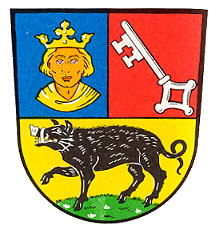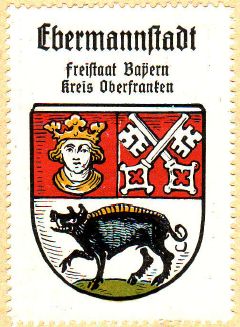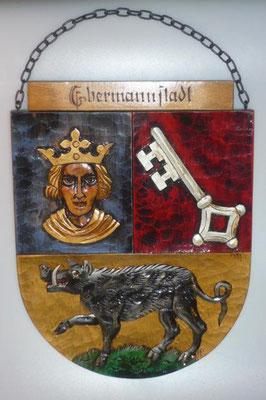Ebermannstadt: Difference between revisions
Knorrepoes (talk | contribs) m (Text replacement - "{{media}}" to " {{de1}} {{media1}}") |
Knorrepoes (talk | contribs) m (Text replacement - "{{de}}" to "") |
||
| Line 1: | Line 1: | ||
'''EBERMANNSTADT''' | '''EBERMANNSTADT''' | ||
Revision as of 15:16, 26 December 2022
EBERMANNSTADT
State : Bayern
District (Kreis) : Forchheim (until 1973 Ebermannstadt)
Additions : 1939 Breitenbach; 1971 Gasseldorf, Neuses, Niedermirsberg, Rüssenbach; 1972 Wohlmuthshül; 1976 Burggaillenreuth, Moggast; 1978 Eschlipp, Wohlmannsgesees (partly)
| German |
Geteilt und oben gespalten; oben vorne in Blau ein golden gekröntes Königshaupt, hinten in Rot ein schräg liegender silberner Schlüssel; unten in Gold auf grünem Boden schreitend ein schwarzer Eber. |
| English | No blazon/translation known. Please click here to send your (heraldic !) blazon or translation |
Origin/meaning
Ebermannstadt received city rights from the King of Bayern in the early 14th century. Already in the oldest seal, which dates from 1323, the canting boar (Eber in German), key and King's head are seen. The key is placed on the boar and the head is placed above. The key is taken from the arms of the Lords of Schlüsselberg (Schlüssel=key), who ruled the town as vassals of the Bavarian Kings until 1347. The seals from 1360-1603 only showed the boar and key. After that the present combination was used on the seals and arms. Later seals and images of the arms, showed two keys, but the latter was removed in 1928 when the arms were officially granted.
| The arms in a 16th century manuscript |
The arms as shown in the Bamberger Vasallentafel from 1603 |
| The arms by Hupp in the Kaffee Hag albums +/- 1925 |
The arms in the Deutsches Wappenmuseum |
Literature: Stadler, 1990; Kaffee Hag albums, 1920s



